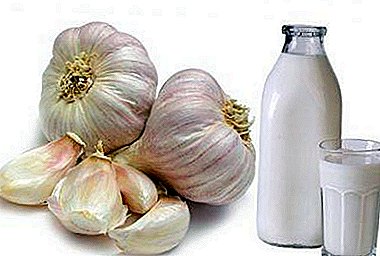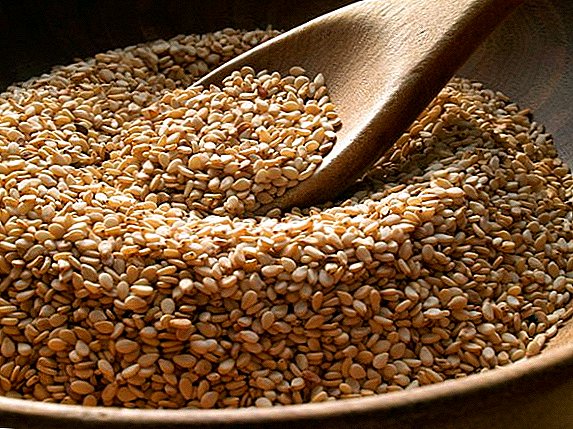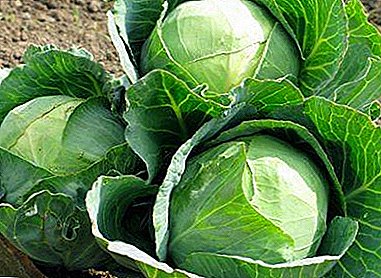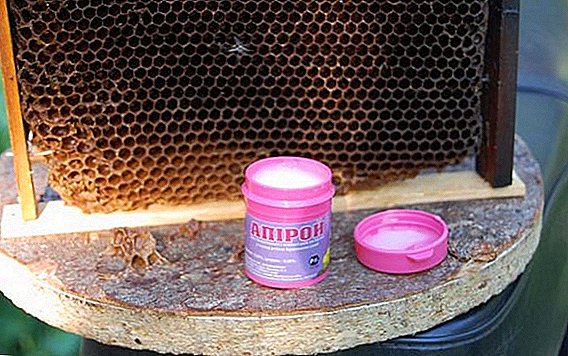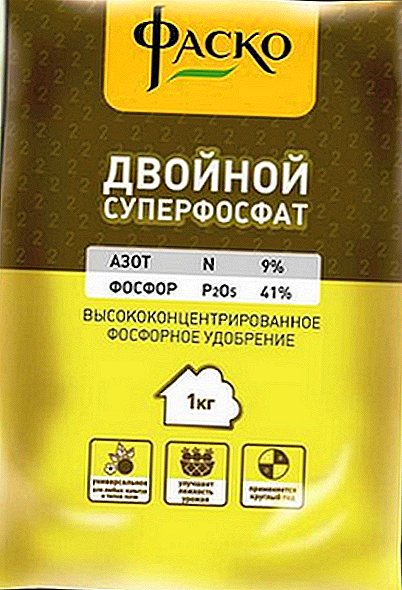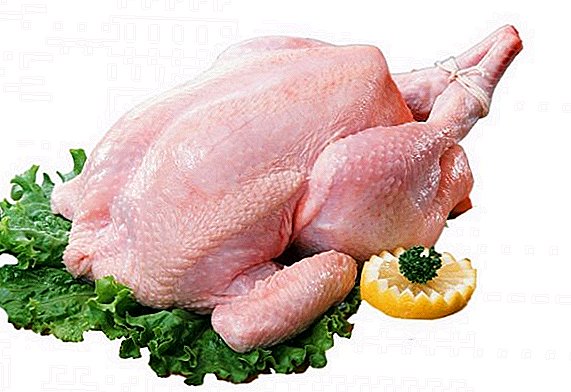 Often, owners of household plots or novice farmers think about starting a small number of poultry in their farms, such as turkeys. But they are stopped by the fact that the breeding of any bird ends in its slaughter, and the potential poultry farmer does not only know how to carry it out, but also fears the process itself. This procedure is really an integral part of the poultry industry, our story about it.
Often, owners of household plots or novice farmers think about starting a small number of poultry in their farms, such as turkeys. But they are stopped by the fact that the breeding of any bird ends in its slaughter, and the potential poultry farmer does not only know how to carry it out, but also fears the process itself. This procedure is really an integral part of the poultry industry, our story about it.
Turkeys before slaughter
The main value of turkey meat - its dietary properties. It has excellent taste and low fat content. More than 1/2 of the carcass is high-quality meat with high protein content and only about 1/4 is fat, most of which is under the skin, that is, it can be easily removed. Therefore, turkey meat is very popular, they breed turkeys both for their own use and for commercial purposes.
Find out how turkeys grow up: highbreed converter, grade maker, big 6, canadian, bronze wide-chested, white wide-chested, bronze 708, uzbek fawn.
How much grow
With proper feeding and care, the bird quickly gains weight, and individual males are able to grow up to 20 kg, females can gain half of this indicator.
For slaughter fits a bird that has gained a weight of over 12 kg. Most turkeys grow to these indicators by the 33-35th week. Many broilers eat such weight by the 17-25th week.

The second indicator is age. It is believed that many breeds of turkeys stop gaining weight after 6-9 months. That is, you need to focus on these terms. Meat after that does not lose its dietary qualities. Even three-year-old turkeys are sent for slaughter, by this age they are of no interest as producers, and their processed meat is quite edible.
Did you know? America is considered the birthplace of turkeys. In 1519, this bird enters Spain, and it was called - Spanish chicken, in the mid-20s of the XVI century, the whole of Europe is already familiar with these birds. By this time, they received another name - the Turkish chickens.
How much is eaten
For 16 weeks, male turkey eats 32 kg of feed. The female during this time needs to feed half the male norm. In more detail, the list of food needed by turkeys for the first 4 months of life is as follows:
- wheat - 10 kg;
- bran - 1.8-1.9 kg;
- greens - 5.7 kg;
- reverse - 300-350 ml;
- curd - 150 g;
- eggs, bone meal, salt, chalk and shells in small quantities.

After 16 weeks, birds are force-fed with dumplings of this composition:
- corn flour - 4 parts;
- oatmeal - 3 parts;
- wheat bran - 5 parts;
- barley flour - 5 parts;
- milk, water or whey - 3 parts;
- salt and yeast.
After 1.5-2 weeks, such a turkey diet can be sent for slaughter, but more often feeding is extended to 2-3 weeks, because such a diet gives a daily increase of 100 g of body weight.
Learn how to keep turkeys in the winter at home.
Preparation for slaughter
For slaughter turkey need to prepare. It is necessary to ensure that the bird is empty during the gastrointestinal tract. Otherwise, this circumstance will complicate gutting, and besides, it may adversely affect the quality of meat. 
- One day before slaughter, stop feeding turkeys.
- In the room where the bird is located, it is necessary to remove the lighting.
- In a dark room should be enough water, you can give a solution of Glauber's salt. Such measures will help the intestines to empty more quickly.
- Shortly before slaughter, you can enter into the diet rye flour or bran.
Important! Turkey meat has the highest protein content. - more than 21 grams per 100 grams of meat, this is more than that of salmon. The meat contains folic acid, all 8 essential amino acids, vitamin K, and less cholesterol than in turkey, only in chicken breast.
Ways of slaughter
In small private farms slaughter of birds is most popular by cutting off the head with an ax. But this method is suitable only in the case of immediate processing of meat. Such slaughter is usually carried out on the street, without observance of sanitary standards, which is fraught with infection with various infectious diseases and parasites.
A carcass with an open wound lies in the air, sometimes on the ground. And in the summer, this method is generally dangerous because of the large number of insects.

If the meat needs to be stored as long as possible without processing, for example, for sale, the closed method is most acceptable, butchering through the beak. The sooner the blood is completely bled, the longer it will be stored.
Interior
In the depths of the palate, the bird has jugular and pavement veins that need to be cut. A bird with this method of slaughter dies from blood loss rather quickly.
External
This method is not as clean as the previous one, however, it is more popular with farmers. Probably for the reason that it requires less skill than the internal method. The very name of the method suggests that the birds' blood vessels open from the outside of the carcass.
Did you know? Famous Jewish surnames Resnik, Shoykhet, Khakham and their derivatives are descended from the Hebrew kosher and poultry slaughter experts. As it is known, Jews are forbidden to eat blood in any form whatsoever. Experts who knew how to properly cut cattle and poultry, completely dehydrating it, were called cutters. Their descendants also became known.
Video: turkey slaughter
Turkey slaughter
Keep in mind that the slaughter of birds is a fairly important procedure, and you need to take it seriously. Even if you act in the old manner, having resorted to the help of an ax, try to at least bring the place of slaughter in line with the minimum sanitary standards. Remember that in the summer, flies, carriers of various infections fly instantly to the blood, and a lot of parasites live in the ground.
Prepare everything you need in advance: dry clean rags, water in sufficient quantities, wash the tool thoroughly (knife, ax). If you opt for an ax, you do not need to do it right on the surface of the old deck. Put some kind of countertop on it, wiping it beforehand.
It is interesting to know how much a turkey and an adult turkey weigh.
Slaughter
If you decide to resort to the internal method of slaughter, you must do it in the following sequence:
- Open the turkey beak and sharply cut the vessels located on the left above the tongue with a sharp knife.
- The blade slightly pulls out and also sharply makes a thrusting blow, but just below and in the center. The brush with a knife should move upwards, its goal is the cerebellum.
- The carcass is suspended by the paws in order to drain the blood.
- Fully bloodless carcass can be plucked.

Plucking
To pluck a bird is best immediately after slaughter. In private farms and small farms, the procedure is carried out manually. In order to qualitatively pluck the carcass, remove all the flight feathers, it is doused with hot water.
Learn more about how to pluck a turkey at home.
The water temperature should not exceed 65 ° C, and the carcass in water lasts no more than a minute. Immediately after removal from the water begin to pluck. This should be done quickly so that the pores do not have time to close, in this case, the flight feathers are very difficult to extract.

When all feathers are removed, it is necessary to give the carcass a normal appearance:
- remove blood from the throat and mouth;
- thoroughly wash the limbs;
- using a dry cloth, remove moisture from the carcass and can be burnt;
- singing at home is carried out over the gas stove, slowly and smoothly conducting the carcass over the fire;
- after removal of the remnants of feathers with fire, one can proceed to gutting.
Important! It is believed that it is better to pluck the turkey immediately, as soon as blood is drained, and it is better to allow the turkey to cool.
Gutting
The procedure for gutting birds carried out in this way:
- On a stable horizontal surface (table) lay the carcass on his back.
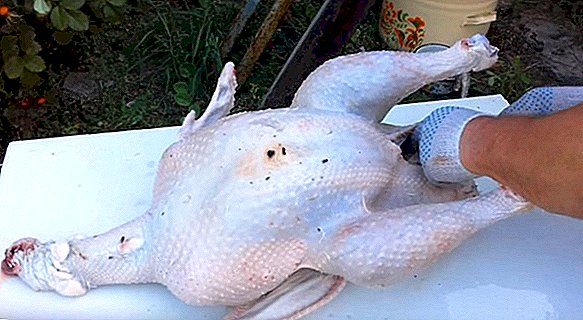
- With one hand they hold the carcass by the sternum, with the other they stick a knife in the center of the belly, just below the rib cage. Moving the knife down, cut the peritoneum.

- From the slot, they take the intestines together with the cloaca.
- Separately remove the stomach, liver, goiter and heart.

In the event that all the offal (along with an empty and flushed stomach) and neck are put back into the womb, the evisceration is considered incomplete. Such meat cannot be stored in the refrigerator for more than 48 hours.
Complete gutting involves removing the neck to the second vertebra, with this, the skin around the neck is also removed, the legs are chopped down to the knees, and the kidneys and lungs remain in the belly of the carcass.
Learn, than turkey, a liver of a turkey, eggs of a turkey is useful.
Meat storage
It is better not to use meat for food immediately after slaughter and gutting. He needs to go through a stage of fermentation, this process is desirable for any meat. Under the action of natural enzymes, the structure of the protein changes, it becomes more acceptable for human consumption, is better absorbed by the body. The ripening of meat passes from 12 hours for young birds, up to 1-2 days for the older.

In the event that for some reason it is not possible to put fresh meat in the refrigerator or freezer, you can use the cellar. A week in a normal cellar carcass can be without problems.
Did you know? Turkeys have a short beak, which is characterized by high hardness. This circumstance allows the bird to make one peck every second, in 5 minutes it can eat 40 grams of grain or 120 grams of mash. Birds also differ in enviable digestion: their digestive tract is able to digest a small nail or glass.
For the same period, the meat can be saved in the following way:
- Prepare a 40% solution of salt. It is necessary to dissolve it in hot water, in a cold such amount will not work.
- The cooled solution is poured into the throat of a bird at the rate of 0.5 cups of solution per 1 kg of mass.
- They tighten the throat with a cord, hang the carcass by the legs in a cool place. After 19-21 hours the lace is removed, the brine is drained.
If you decide to freeze the turkey, you should not neglect fermentation either. The quality of the meat will be better if you let it ripen. In addition, the warm bird freezes through very poorly inside, in this case putrid processes can begin even in the freezer.

The best time to freeze is winter. Let the meat lie down, then it should be taken out in the frost and doused with very cold water. Repeat the procedure until a thin layer of ice forms on the surface of the carcass. After that, the turkey is wrapped in wrapping paper, placed in boxes and wrapped in straw. Store at a temperature of -7 ... -12 ° C.
Of great importance and the duration of defrosting. When frozen, the water displaced from the muscles turns into ice, which in the frozen carcass is located between the muscle fibers. If the meat is thawed slowly, thawing gradually, the muscles absorb moisture back, and with it all the dissolved nutrients.
Accelerated defrosting leads to loss of taste, since the fabrics simply do not have time to soak back all the liquid. As a result, the meat not only loses the taste, but also the nutrients.
Important! Turkey egg production is 55-90 pieces per year. At the same time, autumn eggs are practically not used for incubation, as the nestlings bred closer to winter have a poor survival rate.
Turkey slaughtering and plucking in winter: video
Slaughter turkeys requires certain skills. After all, the wrong procedure can spoil the meat, which at best will go to feed animals. And in the summer, most likely, it will have to be thrown away. In addition, you need to keep in mind that this is quite traumatic process. A living creature feels that they want to take his life, and will escape.
At this time, an inexperienced poultry farmer can shake his hand, he will injure himself and only hurt the bird, causing it suffering. Therefore, before picking up a knife or an ax, try to prepare for the upcoming procedure with full responsibility.
How to score a turkey: reviews
Now I myself keep such a little 2nd year.
The problem was solved - I take the old bag - I make a hole with my fist in one of the corners, put it on the turkey and show him where the "ray of light in the dark kingdom"
He himself put his head there - from behind, either he squeezed with his hand, or he grabbed it with a loop with a loop, so that he could be hung up. He flutters, and the bag does not give. Then everything is standard - with an ax bale and hang, so that the blood flowed.
Although the cones are more fun, I have only about a dozen of them - the view of the “frontal place” throughout the year does not inspire me







